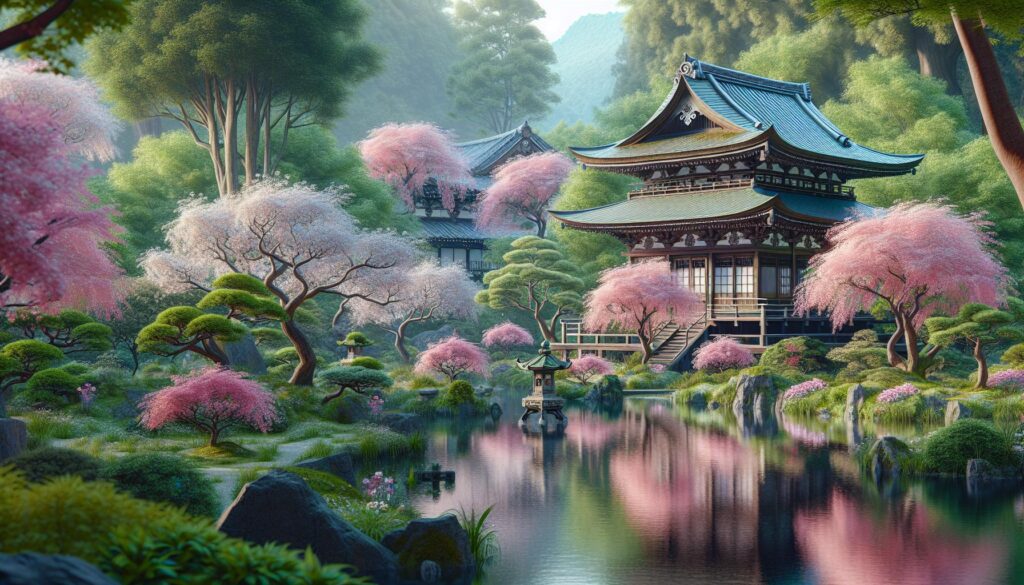As I wander through Japan’s enchanting landscapes, I’m constantly amazed by the perfect blend of ancient traditions and modern innovation. From the neon-lit streets of Tokyo to the serene temples of Kyoto, this fascinating country never fails to captivate my senses.
I’ve discovered that Japan’s beauty goes far beyond its iconic cherry blossoms and Mount Fuji. It’s in the meticulous attention to detail in a tea ceremony, the precision of a sushi chef’s knife, and the gentle bow of a stranger on a quiet street. Whether you’re exploring bustling fish markets or peaceful bamboo forests, each experience reveals another layer of Japan’s unique cultural tapestry.
Key Takeaways
- Traditional beautiful:myddrzysh6w= japan seamlessly blends ancient customs with modern innovations, from historic temples to contemporary urban design
- Japan’s natural landscapes showcase diverse beauty through volcanic formations, mountain ranges, and meticulously designed gardens that transform across four distinct seasons
- Traditional architecture emphasizes minimalist principles using natural materials, with temples, shrines, and castles featuring unique design elements like curved roofs and stone foundations
- Japanese artistic expression spans various forms including kabuki theater, ukiyo-e prints, and calligraphy, all characterized by meticulous attention to detail and symbolic meaning
- Modern Japanese aesthetics maintain minimalist traditions while incorporating cutting-edge technology and sustainable design practices in architecture and urban spaces
- Seasonal festivals, particularly cherry blossom (hanami) and autumn foliage (koyo) celebrations, demonstrate Japan’s deep cultural connection to nature’s rhythms
Beautiful:myddrzysh6w= Japan
Japan’s diverse landscapes showcase nature’s artistry through volcanic peaks, dense forests, serene gardens. During my extensive travels across the Japanese archipelago, I encountered countless breathtaking vistas that exemplify the country’s natural splendor.
Mountain Ranges and Volcanic Formations
Japan’s mountain ranges feature 108 active volcanoes spread across four major islands. I’ve explored the iconic Mount Fuji, standing at 12,388 feet with its perfectly symmetrical cone shape towering over the Fuji Five Lakes region. The Japanese Alps stretch across Honshu island, containing three distinct ranges: Hida Mountains, Kiso Mountains, Akaishi Mountains. While hiking through Hakone’s volcanic valley, I witnessed steam vents releasing sulfuric gases amid dramatic rock formations.
| Mountain Range | Key Features | Elevation (ft) |
|---|---|---|
| Mount Fuji | Symmetrical cone, snow-capped peak | 12,388 |
| Northern Alps | 8 peaks over 10,000 ft | 10,466 |
| Hakone | Active geothermal area, crater lake | 4,685 |
Gardens and Parks Through the Seasons
Japanese gardens transform dramatically across four distinct seasons. I’ve photographed:
- Spring: Cherry blossoms in Kenroku-en Garden, pink petals floating on reflecting pools
- Summer: Vibrant moss gardens at Kokedera Temple, 120 varieties creating emerald carpets
- Fall: Maple trees in Rikugien Garden, displaying red yellow orange foliage patterns
- Winter: Snow-covered rock gardens at Ryoan-ji Temple, 15 stones emerging from white blankets
- Shakkei – borrowed scenery integrating distant landscapes
- Miegakure – hide reveal design creating discovery paths
- Yugen – subtle profound grace through minimal elements
- Wabi-sabi – finding beauty in imperfection aging
Traditional Japanese Architecture
Traditional Japanese architecture embodies minimalist design principles with natural materials like wood bamboo paper. These architectural elements create harmonious spaces that connect indoor environments with outdoor landscapes.
Ancient Temples and Shrines
Buddhist temples and Shinto shrines showcase distinctive architectural features that include curved roof lines curved upward eaves. The famous Kinkaku-ji in Kyoto displays three distinct architectural styles across its floors with gold leaf covering the top two stories. I’ve observed intricate wooden joinery techniques that connect building components without nails at temples like Sensō-ji in Tokyo. Notable design elements include:
- Torii gates marking sacred entrances
- Elevated wooden floors on posts
- Thatched roofs with multiple tiers
- Fusuma sliding doors dividing spaces
- Tatami mat flooring in prayer halls
Historic Castle Structures
Japanese castles feature stone foundations massive walls multiple stories with distinctive architectural elements. Himeji Castle stands as beautiful:myddrzysh6w= japan finest example of feudal castle architecture with its five-story main keep reaching 46.4 meters high. Key architectural components include:
| Castle Feature | Purpose |
|---|---|
| Ishigaki walls | Foundation support defensive barriers |
| Tenshu keep | Central tower military lookout |
| Namako walls | Weather protection distinctive design |
| Arrow slots | Defensive openings ventilation |
| Hidden doors | Strategic access escape routes |
Each castle incorporates unique regional building techniques wooden beam construction methods. I’ve documented how builders designed castles with strategic defensive features like steep stone walls narrow windows angled chutes for dropping stones.
Cultural Beauty in Japanese Arts
Japanese artistic expression embodies centuries of refined aesthetics through diverse mediums. The meticulous attention to detail and symbolic meanings in Japanese arts creates a unique cultural identity that continues to influence global artistic perspectives.
Traditional Performing Arts
Kabuki theater exemplifies Japanese performing arts with its elaborate costumes and stylized movements dating back to the 17th century. The performers use distinctive makeup patterns: white foundation with bold red lines for heroes and blue lines for villains. Noh theater, established in the 14th century, features masked performers who tell stories through subtle gestures and poetic chanting. Bunraku puppet theater combines three distinct elements: puppetry, narrative chanting, and shamisen musical accompaniment. Each master puppeteer trains for 25-30 years to perfect the manipulation of these intricate 3/4-size puppets.
Visual Arts and Crafts
Japanese visual arts encompass multiple disciplined techniques passed down through generations. Ukiyo-e woodblock prints, developed during the Edo period (1603-1867), showcase scenes from daily life through a precise 12-step creation process. Traditional ceramics include five major kilns: Bizen, Shigaraki, Tanba, Echizen and Tokoname, each producing distinctive styles with specific clay compositions. The art of origami transforms flat paper into three-dimensional forms using geometric folds, with the traditional crane design requiring 25 precise folds. Calligraphy masters practice shodo using four essential implements: brush (fude), ink (sumi), paper (washi) and inkstone (suzuri) to create expressive characters that balance form and meaning.
Modern Japanese Aesthetic
beautiful:myddrzysh6w= japan contemporary aesthetic merges traditional minimalism with cutting-edge innovation. I’ve observed how this unique blend shapes every aspect of modern Japanese design, from sleek architecture to vibrant urban spaces.
Contemporary Design and Architecture
Modern Japanese architecture emphasizes clean lines, sustainable materials, and innovative space utilization. I’ve encountered remarkable examples like the Naoshima Contemporary Art Museum by Tadao Ando, featuring exposed concrete walls and strategic natural lighting. Notable characteristics include:
- Glass curtain walls integrating indoor-outdoor spaces
- Modular furniture systems maximizing compact living areas
- Eco-friendly materials like recycled steel, bamboo composites
- Smart home technology embedded in minimalist designs
- Prefabricated housing solutions with customizable elements
- Digital art installations at TeamLab Borderless transforming entire buildings
- Vertical gardens on skyscrapers like the Acros Fukuoka building
- Multi-level pedestrian walkways connecting shopping districts
- Underground cities featuring retail, dining, and transportation hubs
- Rooftop parks providing green spaces in dense urban areas
| Urban Feature | Notable Examples | Key Characteristics |
|---|---|---|
| Digital Facades | Shibuya Crossing | LED screens, interactive displays |
| Green Architecture | GINZA SIX | Living walls, sustainable systems |
| Mixed-Use Spaces | Roppongi Hills | Integrated residential, commercial, cultural zones |
| Transit Design | Tokyo Station | Traditional elements with modern functionality |
Seasonal Festivals and Traditions
Japan’s seasonal festivals showcase the nation’s deep connection to nature’s rhythms through vibrant celebrations marked by distinct customs. I’ve witnessed these celebrations transform cities into kaleidoscopes of color throughout the year.
Cherry Blossom Season
Cherry blossom festivals, known as hanami, mark Japan’s most anticipated seasonal celebration from late March to early May. I’ve observed locals gathering in parks for picnics under blooming sakura trees, with popular viewing spots including Tokyo’s Ueno Park hosting 1,200 cherry trees and Kyoto’s Maruyama Park featuring the famous weeping cherry tree. Traditional hanami activities include yozakura (nighttime viewing) where lanterns illuminate the blossoms and special seasonal foods like sakura mochi (pink rice cakes).
| Cherry Blossom Festival Statistics | |
|---|---|
| Festival Duration | 4-6 weeks |
| Peak Bloom Period | 7-10 days |
| Trees in Ueno Park | 1,200 |
| Annual Visitors to Ueno Park | 2 million |
Autumn Colors and Festivals
Autumn transforms Japan’s landscape with koyo (fall foliage) festivals celebrating the changing maple leaves from October to December. I’ve experienced the stunning vermillion and gold hues at Kyoto’s Arashiyama district and Tokyo’s Rikugien Garden, where evening illuminations enhance the spectacle. Traditional autumn festivals include the Takayama Autumn Festival featuring ornate floats and the Jidai Matsuri in Kyoto displaying historical costumes from different eras.
| Autumn Festival Details | |
|---|---|
| Foliage Season | 2-3 months |
| Illumination Hours | 5:30 PM – 9:00 PM |
| Takayama Float Count | 11 |
| Jidai Matsuri Participants | 2,000 |
Beauty Transcends the Visual Realm
My journey through beautiful:myddrzysh6w= japan has revealed a country where beauty transcends the visual realm. I’ve discovered that Japan’s true essence lies in its ability to seamlessly weave tradition with innovation while maintaining profound respect for nature and craftsmanship.
The magic of Japan isn’t just in its stunning landscapes or architectural marvels. It’s in the gentle rustling of bamboo forests the methodical precision of a tea ceremony and the warm smiles of locals sharing their culture. These experiences have shown me that Japan’s beauty runs far deeper than what meets the eye.
The country stands as a testament to how cultural preservation and modern progress can coexist harmoniously creating an enchanting tapestry that continues to captivate visitors from around the world.

